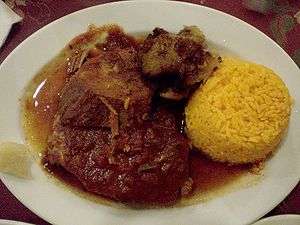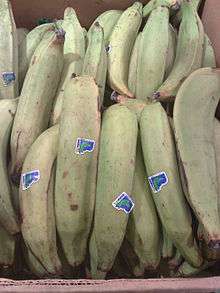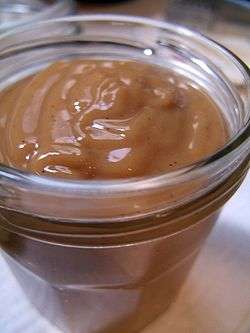Cuban cuisine
| Part of a series on |
| Life in Cuba |
|---|
 |
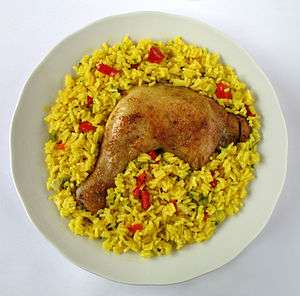
Cuban cuisine is a blend of Native American Taino food, Spanish, African, and Caribbean cuisines. Some Cuban recipes share spices and techniques with Spanish and African cooking, with some Caribbean influence in spice and flavor. This results in a unique, interesting and flavorful blend of the several different cultural influences, with strong similarities with the cuisine of the neighboring Dominican Republic and Puerto Rico. A small but noteworthy Chinese influence can also be accounted for, mainly in the Havana area. During colonial times, Cuba was an important port for trade, and many Spaniards who lived there brought their culinary traditions along with them.[1]
As a result of the colonization of Cuba by Spain, one of the main influences on the cuisine is from Spain. Along with Spain, other culinary influences include Africa, from the Africans that were brought to Cuba as slaves, and French, from the French colonists that came to Cuba from Haiti.[1] Another important factor is that Cuba itself is an island, making seafood something that greatly influences Cuban cuisine. Another contributing factor to Cuban cuisine is the fact that Cuba is in a tropical climate. The tropical climate produces fruits and root vegetables that are used in Cuban dishes and meals.[2]
A typical meal would consist of rice and beans, cooked together or apart. When cooked together the recipe is called either "Congri" or "Moros" or "Moros y Cristianos" (black beans and rice). If cooked separately it is called "Arroz con/y Frijoles" (rice with/and beans).[3]
Rice and beans are a culinary element found throughout Cuba, although it varies by region. In the eastern part of the island, "arroz congri oriental" is the predominant rice and bean dish. White rice and red kidney beans are cooked together with a sofrito and then baked in the oven. The same procedure is used for the above-mentioned Congri (also known by the terms Arroz Moro and Moros y Cristianos – literally "Moors and Christians") which instead uses black beans. Although the process of preparing the black bean soup contains basics (onion, garlic, bay leaf, salt) each region has their tradition of preparing it.
Meat, when available on ration book is usually served in light sauces. The most popular sauce, used to accompany not only roasted pork, but also the viandas, is Mojo or Mojito (not to be confused with the Mojito cocktail), made with oil, garlic, onion, spices such as oregano and bitter orange or lime juice. The origin of Cuban mojo comes from the mojo sauces of the Canary Islands. Cuban mojo is made with different ingredients, but the same idea and technique are used from the Canary Islands. Of course with so many Canary Islander immigrants in Cuba, the Canary Islander influence was strong. Ropa vieja is shredded beef dish (usually flank) simmered in tomato-based criollo sauce until it falls apart. Ropa Vieja is the Spanish name meaning "old clothes", in which the dish gets its name from the shredded meat resembling "old clothes". Ropa vieja is also from the Canary Islands, as are many of the origins of Cuban food. Boliche is a beef roast, stuffed with chorizo sausage and hard boiled eggs.
Sandwiches
Cuban sandwich
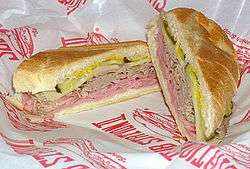
A Cuban sandwich (sometimes called a "mixto", especially in Cuba[4][5]) is a popular lunch item that grew out of the once-open flow of cigar workers between Cuba and Florida (specifically Key West and Ybor City, Tampa) in the late 1800s and has since spread to other Cuban-American communities.[6][7][8]
The sandwich is built on a base of lightly buttered Cuban bread and contains sliced roast pork, thinly sliced Serrano ham, Swiss cheese, dill pickles, and yellow mustard. In Tampa, Genoa salami[9] is traditionally layered in with the other meats, probably due to influence of Italian immigrants who lived side-by-side with Cubans and Spaniards in Ybor City.[10] Tomatoes and lettuce are available additions in many restaurants, but these are considered by traditionalists as an unacceptable Americanization of the sandwich.[4][11]
After assembly, the Cuban sandwich may be pressed in a grooveless panini-type grill called a "plancha", which both heats and compresses the contents.[4] It is usually cut in half diagonally before serving.
Other sandwiches
A medianoche sandwich is very similar to a Cuban sandwich except that Cuban bread is replaced by an egg loaf and ham is sometimes excluded. It received its name (medianoche means "midnight") from its popularity as a midnight snack in the nightclubs of Havana.
Pan con lechón is a traditional pressed sandwich created simply with Cuban bread, roasted pork, onions, and mojito. Pan con bistec is made in the same fashion, but the pork is replaced with a thin sirloin steak (palomilla).
Another sandwich of Cuba is the "Elena Ruz". Elena Ruz was a young society debutante in the 1930s who would stop at El Carmelo, a popular restaurant and confectionery shop in Havana after an evening at the opera or a social function, and would ask the waiter if he would fix her a sandwich to her orders. It is prepared on white or Cuban bread, with a layer of cream cheese on one slice, a layer of strawberry jam or preserves on the other, and thin slices of turkey breast in between.[12]
Other traditional sandwiches include pan con timba (bread with guayaba paste and cream cheese), pan con chorizo also known as choripán (Cuban bread with thin cut Spanish chorizo sausage), and the frita.
The frita became popular in Cuba in the 1930s. It is a Cuban version of the American hamburger, although with significant changes. It is prepared with ground beef mixed with ground chorizo. The patties are made small and fried on a griddle. The fried patty is served in a small Cuban bread hamburger bun, topped with onion and julienne potato fries.
List of Cuban dishes
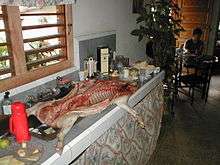
- Arroz con leche
- Arroz con maiz
- Arroz con pollo
- Batido
- Bistec de Palomilla
- Boliche
- Buñuelo
- Butifarra
- Camarones
- Chivirico
- Croqueta
- Cucurucho
- Dulce de leche
- Empanada
- Flan de calabaza
- Flan de coco
- Flan de guayaba
- Flan de huevos
- Frijoles negros
- Frita
- Fufú de Plátano
- Guayaba
- Medianoche
- Mermelada
- Mojo Criollo
- Morcilla
- Moros y Cristianos
- Natilla
- Papa rellena
- Papitas fritas
- Pasteles
- Picadillo
- Platano maduro frito
- Pudín de pan
- Pulpeta
- Ropa vieja
- Sandwich Cubano
- Sopa de pollo
- Tamale
- Tortilla de patatas
- Tostada
- Tostones
- Tres leches cake
- Turrones
- Vaca Frita
- Yuca con mojo
- Yuca frita
List of Cuban drinks

- Cuba Libre - Rum, Coke-Cola, sugar, and lime
- Daiquiri
- El Presidente
- Guarapo - juice made from pressed sugar cane
- Hatuey beer
- Havana Cooler - Rum, mint, sprite or ginger ale
- Ironbeer
- Malta (soft drink) - malt beverage
- Materva
- Mojito - Rum, mint, sugar, lime, and club soda
See also
References
- 1 2 Rodriguez, H. "Cuban Food Profile: Cuban Food History"
- ↑ Murray, J. "Cuban Cuisine, Cuba History and Their Food"
- ↑ "Frijoles Negros"
- 1 2 3 Cuban Sandwich Wars Inflame Passions In Tampa And Miami | Florida Vacation, Tourism, Travel & Entertainment Information - VISITFLORIDA.com
- ↑ http://www.sptimes.com/2003/01/18/TampaBay/To_each__his_own_sand.shtml
- ↑ "Sink teeth into quest for best Cuban sandwich".
- ↑ "Welcome to Cuban Sandwich City" - Cigar City Magazine
- ↑ "Tampa History is Traced in its Sandwich" - The Tampa Tribune
- ↑ Three Guys From Miami (n.d.). "Sandwich Cubano / Cuban Sandwich". iCuban website.
- ↑ Otto, Steve (24 October 2007). "Cuban Is Ours, Any Way You Try To Slice It". The Tampa Tribune. Archived from the original on 7 May 2009.
- ↑ Stern, Jane and Michael (2009). 500 Things to Eat before It's Too Late and the Very Best Places to Eat Them. Boston: Houghton Mifflin Harcourt. ISBN 978-0-547-05907-5.
- ↑ Elena Ruz Turkey Sandwich recipe | Cuban Elena Ruth
Bibliography
- Aróstegui, Gonzalo, et al.: Manual del Cocinero Criollo, Cuba, 19th century.
- Buchmann, Christine. "Cuban Home Gardens and Their Role in Social–Ecological Resilience." Human Ecology: An Interdisciplinary Journal 37.6 (2009): 705-721. 16 Jan. 2010.
- Cancio-Bello, Carla. "The Growing Popularity of Cuban Cuisine." (2012): http://www.cubancuisine.co.uk
- Folch, Christine. "Fine Dining: Race in Prerevolution Cookbooks." Latin American Research Review 43.2 (2008): 205-223. 3 Feb. 2010.
- Hunt, Nigel. "The Agriculture History in Cuba." Cuba Agriculture. 2008. Web. 11 Feb 2010.
- Murray, James. "Cuban Cuisine, Cuba History and Their Food." 2009. Articlesbase. Web. 16 January 2010.
- Reyes Gavilán y Maen, Maria Antonieta: Delicias de la mesa. Manual de Cocina y Reposteria, 12ed., Ediciones Cultural S.A., La Habana, 1952.
- Rodriguez, Hector. "Cuban Food Profile: Cuban Food History." 2010. Latinfood.about.com. Web 16 January 2010.
- Villapol, Nitza: Cocina Cubana, 3ed., ISBN 959-05-0042-0, Editorial Cientifico-Técnica, Habana, 1992.
- Warwick, Hugh. "Cuba's Organic Revolution." Forum for Applied Research & Public Policy 16:2(2001): 54-58. 27 Feb. 2010.
- Historical Aspects of Cuban Cuisine
- Brenner, Philip, Jimenez, Marguerite, Kirk, John, and Leo Grunde, William. A Contemporary Cuba Reader: Reinventing the Revolution. Rowman and Littlefield Publication. 2008.
- Harpers Weekly. Starvation in Cuba. The New York Times: May 30, 1897.
- Hernandez, Rafael. Looking at Cuba: Essays on Culture and Civil Society. University of Florida Press, 2003. P. 101
- Houston, Lynn Marie. Food Culture Around the World: Food Culture in the Caribbean. Westport, Connecticut: Greenwood Press, 2005. Pg. 115-116.
- Maria Josefa Lluria de O’Higgins. A Taste of Old Cuba: More Than 150 Recipes for Delicious, Authentic, and Traditional Dishes Highlighted with Reflections and Reminiscences. New York: Harper Collins Publisher. 1994.
- Pieroni, Andrea and Price, Lisa L. Eating and Healing: Traditional Food as Medicine. New York, 2006. Haworth Press Inc.
- Randelman, Mary U. and Schwartz, Joan, Memories of a Cuban Kitchen: More than 200 classic recipes. New York: Macmillan. 1992.
External links
| Wikibooks Cookbook has a recipe/module on |
- Guije--Compilation of recipes derived from cookbooks published in Cuba
- Free Cuban recipes
- Authentic Cuban Food Recipes
- Eating the Cuban way
- Three Guys From Miami Cuban Food Recipes
- Cuban Cuisine Article
- Arroz y Frijoles Cuban Food & Drink
- Best Cuban Recipes
